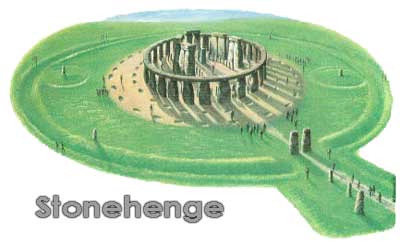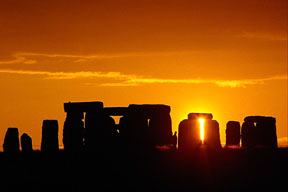BAMBU Latest Issues
BAMBU-13
See also:
BAMBU Archives: Contents
Brit-Am Megalithic Bulletin Update (BAMBU)
NEWS AND INFORMATION
Tracing The Israelite Paths of Migration
according to the Directions of the Prophet Jeremiah 31:21

Dolmens and Megaliths
BAMBU-13
Brit-Am Megalithic Bulletin Update
Contents:
1. Two Articles on Stonehenge Astronomy
and Mathematical Expertise
2. Study: Stonehenge was a burial site for centuries
3. Astronomical Alignment of "almost all megalithic remains" now accepted
1. Two Articles on Stonehenge Astronomy
and Mathematical Expertise
(1) Stonehenge builders had geometry
skills equivalent to Pythagoras
http://www.newkerala.com/one.php?action=fullnews&id=65329
Extracts:
London, May 27 : A new study has revealed that the builders of the Stonehenge
had a sophisticated knowledge of geometry to rival that of even Pythagoras, the
ancient Greek mathematician.
According to a report in The Independent, five years of detailed research,
carried out by the Oxford University landscape archaeologist Anthony Johnson,
has claimed that Stonehenge was designed and built using advanced geometry.
The geometrical knowledge eventually used to plan, pre-fabricate and erect
Stonehenge was learnt empirically hundreds of years earlier through the
construction of much simpler monuments, according to Johnson.
The most complex geometrical achievement at Stonehenge is an 87-metre diameter
circle of chalk-cut pits which mark the points of a 56-sided polygon, created
immediately within the monument's perimeter earthwork.
Johnson used computer analysis and experimental archaeology to demonstrate that
this outer polygon was laid out using square and circle geometry.
The experimental archaeology demonstrates that most of the monument was
pre-planned and that the great stones were pre-fabricated off-site and then
installed by surveyor-engineers.
"For years people have speculated that Stonehenge was built as a complex
astronomical observatory. My research suggests that, apart from mid-summer and
mid-winter solar alignments, this was not the case," saidJohnson.
(2) Stonehenge builders had geometry
skills to rival Pythagoras
By David Keys, Archaeology Correspondent
http://tinyurl.com/6a9msd
Extracts:
Five years of detailed research, carried out by the Oxford
University landscape archaeologist Anthony Johnson, claims that Stonehenge was
designed and built using advanced geometry.
The discovery has immense implications for understanding the monument, and the
people who built it. It also suggests it is more rooted in the study of geometry
than early astronomy, as is often speculated.
Mr Johnson believes the geometrical knowledge eventually used to plan,
pre-fabricate and erect Stonehenge was learnt empirically hundreds of years
earlier through the construction of much simpler monuments.
He also argues that this knowledge was regarded as a form of arcane wisdom or
magic that conferred a privileged status on the elite who possessed it, as it
also featured on gold artefacts found in prehistoric graves.
The most complex geometrical achievement at Stonehenge is an 87-metre diameter
circle of chalk-cut pits which mark the points of a 56-sided polygon, created
immediately within themonument's perimeter earthwork.
Mr Johnson used computer analysis and experimental archaeology to demonstrate
that this outer polygon was laid out using square and circle geometry. He
believes the surveyors started by using a rope to create a circle, then laid out
the four corners of a square on its circumference, before laying out a second
similar square, thus creating an inner octagon. The points of the octagon were
then utilised as anchors for a surveyor's rope which was used to "draw" arcs
which intersected the circumference so as to progressively create the sides of a
vast polygon.
Indeed, his work has demonstrated that a 56-sided polygon is the most complex
that can easily be created purely through square and circle geometry using a
single piece of rope.
It is likely that this basic limitation determined the number of sides of
Stonehenge's outer polygon, and may also have led to the 56-sided polygon
concept becoming important within wider European religious belief. Ancient Greek
classical mythology associated just such a 56-sided polygon with Zeus's great
rival for divine supremacy, the weather god Typhon.
Johnson's research, published as a book this week, shows that Stonehenge derived
its design from geometrical knowledge and features no less than six concentric
polygons, a 56-sided outer one built around 2950BC; a regular octagon built
around 2500BC) inside that; two concentric (though partly inaccurate) 30-sided
polygons built around 1650BC, which were based on a series of hexagons; a
30-sided inner polygon (the sarsen stone ring which was built around 2500BC)
also based on hexagonal geometry; and two probable 40-sided concentric polygons
(probable former blue stone positions built around 2600BC) that were later
modified to 30-sided ones. They also created the famous central stone
"horseshoe" utilising the survey markers used to create the thirty-sided sarsen
polygon.
The experimental archaeology demonstrates that most of the monument was
pre-planned and that the great stones were pre-fabricated off-site and then
installed by surveyor-engineers.
"For years people have speculated that Stonehenge was built as a complex
astronomical observatory. My research suggests that, apart from mid-summer and
mid-winter solar alignments, this was not the case," said Mr Johnson. "It
strongly suggests that it was the knowledge of geometry and symmetry which was
an important component of the Neolithic belief system."
"It shows the builders of Stonehenge had a sophisticated yet empirically derived
knowledge of Pythagorean geometry 2000 years before Pythagoras," he said.
A leading British prehistorian, Sir Barry Cunliffe, from Oxford University,
believes that Anthony Johnson's research is "a major step forward in solving the
puzzle of Stonehenge".
2. Study: Stonehenge was a burial site
for centuries
http://news.yahoo.com/s/ap/20080529/
ap_on_sc/sci_stonehenge;_ylt=AnWvg7SKT9l
3. Astronomical Alignment of "almost
all megalithic remains" now accepted
Casting Stones
by Philipp Coppens
http://www.philipcoppens.com/megaliths.html
Extracts:
Major
inroads into the megalithic
civilisation were created by
Gerald Hawkins and Alexander Thom. Hawkins stated that Stonehenge clearly
displayed astronomical knowledge and hence concluded it was a calendar.
Archaeologists disagree with the calendar, but do agree that the alignments of
Stonehenge are there because the builders had specific ritual festivities at the
main events of the sun: the equinoxes and the solstices. Thom concluded that
many of the lesser known monuments also had stellar alignments; and his research
occurred largely in Brittany, thus showing that the astronomical component of
the megalithic structures seemed at the core of the building of the monuments
itself. Since then, this possibility has been confirmed in almost all megalithic
remains, as far as Egypt. Still, when their theories were originally aired, Thom
and Hawkins were largely treated as
parias
in the scientific community.
Much less known, yet equally impressive,
is the 20 year long study performed by Aubrey Burl, who finished his overview of
hundreds if not thousands of megalithic monuments in Europe in the mid 1990s.
His conclusion read that the first crude stone structures were created in the
Lake District, north-western England. From there, they spread South, towards
Wessex,
Devon and Cornwall. From there, they reached south-western Ireland. Northern
Ireland was "seeded" directly from the Lake District, as it was a short stretch
of water that separated the two locations. As to their purpose, Burl was very
careful, but did suggest that he felt they had a religious purpose, though a
dual purpose, such as meeting place for tribes or between tribes, was most
likely a secondary purpose of the sites.
other researchers have come to the
conclusion that many megalithic monuments were indeed situated along ancient
roads.
Join the Brit-Am Ephraimite Discussion Group
Just Send an
e-mail
with "Subscribe" in the Subject Line
and in the Message Space
Main Page
Your Offerings and Orders for our Publications







